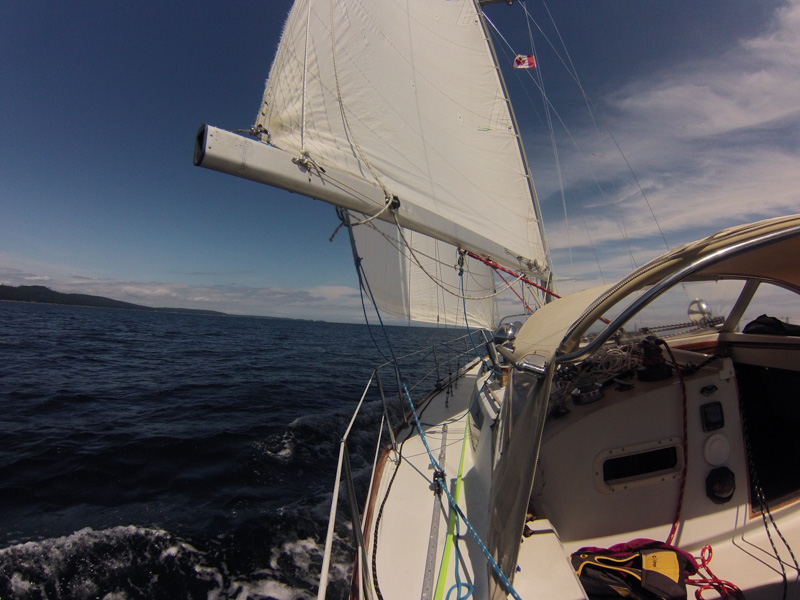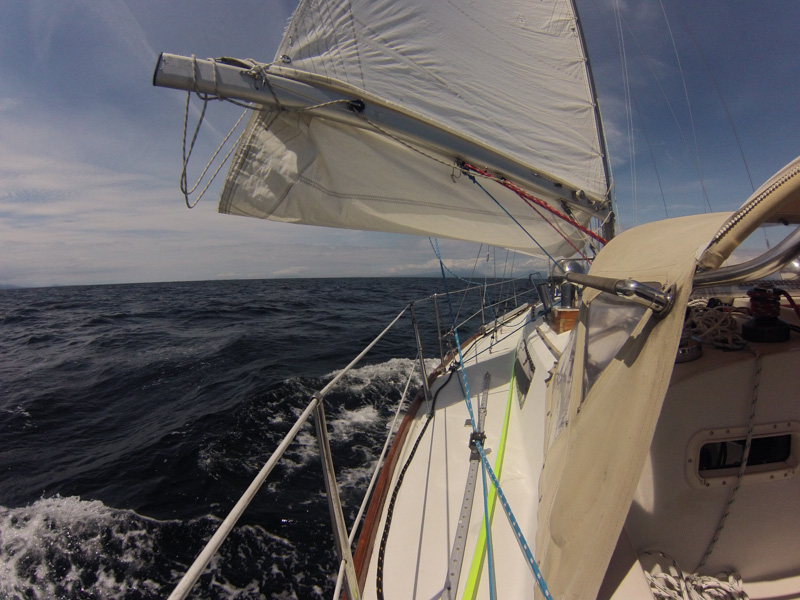As the waves settled out a bit from their previous roar, we said (for the fourth time), “Things are looking better now.” No sooner had we said that than another series of rollers came along. The boat rolled from toerail to toerail. We could hear the wave coming by the roar of the breaker. Breaking waves don’t normally happen outside the ocean, but minor ones do happen when you have 3-4 foot waves at 3 seconds.
Each time bigger waves hit our stern quarter, the wave crest would push the boat’s stern, causing us to start to round up – in 20 knot winds. So I have to anticipate every wave and react quickly and forcefully with steering. As a wave lifts us up, the boat surfs and we drive down it. We’re doing 7 knots at times, under a single reefed main and no foresail.
We were in the Strait of Georgia – a seemingly routine waterway east of Nanaimo – heading from Porlier Pass in the Gulf Islands to Pender Harbor, on Tuesday. We knew we’d have a flood current with a southerly wind – two good things, since you want wind following current, and the wind here is usually not southerly, but southerly allows us to sail downwind which is much easier than upwind in choppy waves. We expected a downwind sleigh ride. But it wasn’t working out as well as hoped – high wind is manageable, but the short steep swell was an issue.

Easy sailing – We began the crossing with 10 kts, on a broad reach
We had prepared for this – Waggoner’s guide warns the Strait of Georgia can be tough. We had rigged the jacklines, stowed the dinghy on deck, prepped snacks, ginger and seasickness bands. Conditions when we started out were benign – wind ESE 10-12 kts, with Halibut bank reporting 0.5m waves at 3 seconds. We had fun sailing in 10-12 kts and later reefed when they got to 14-15. But the waves built quickly, in a 3 mile radius around Halibut Bank (covering nearly the entire strait, making them unavoidable). When we passed by Halibut Bank, according to the buoy history, we had winds at 18 gusting to 21, with 0.7m waves at 3 seconds. 0.7 meters (~2.25 feet) seems pretty mild – but perhaps the buoy is conservative – and it’s probably average wave height – the larger ones seemed more like 3-4’. And the period (3 seconds) makes a big difference too.

Slightly harder sailing (one reef in the main), but still easy waves. I have no pictures of the worse waves, because I couldn’t take my hands of the wheel to take a picture.
Eventually we got shelter behind Merry Island and sailed through Welcome Passage, past Secret Cove. The flood current gave us a 2-3 knot push through Welcome Passage. And the swell disappeared to a mere 1/2 foot chop – basically flat water in comparison. Sailing in 20 knots became enjoyable again.
Reflecting
Each time we get ourselves in a situation like this we wonder whether we’re doing something wrong. We don’t hear of other cruisers going through conditions like this – are they avoiding it by motoring in the mornings instead? Or are we just uncomfortable in conditions that other sailors consider mundane?
My guess is most don’t cross the Strait of Georgia with a forecast over 15 knots, even with wind and current aligned. We saw no other sailboats crossing on Tuesday, and only two sailboats on the west side (heading to/from Nanaimo). The only other boats were a 50’ fishing boat heading upwind mid-Strait in what looked like a miserable ride – pounding into the swell taking huge waves over his bow – and a large motor yacht (75′?) hugging the shore. So we probably made the wrong choice deciding to sail across in the afternoon rather than motor in the early morning. But we like to sail more than motor.
In the end we sailed 100% of the way from Porlier Pass to Pender Harbor, including sailing into Pender Harbor (a tricky entrance) up to Garden Bay (turning on the engine to anchor, since the anchorage is small and crowded). While we were exhausted and beat, it felt like an accomplishment. And our reward the next day would be something we’d been seeking for three days now since checking into BC – a real grocery store!

Finally back to easy sailing – after getting out of the Strait of Georgia we found protection in the flat waters of Welcome Passage (still with 20 knots of wind)

Sounds like a rolly ride.
Here in New Zealand at 45 degrees south almost all our sailing is done in at least 15-25 ish knots of wind. The sea breeze tends to funnel down our Harbour and depending on the tide it creates the conditions you are talking about with the short steep waves.
Hopefully by the sounds of it, this will have been good training for when we head off around the world. A consistent 10-15 kts of breeze sounds like paradise!
Happy travels 🙂
Sounds like you’ll be well prepared by that. I think wave management is in many ways harder than wind management (which can be hard too, but most books talk about wind techniques a lot, but waves little).
New to cruising with an old C&C34. I find your postings most interesting and helpful. I’m out of Vancouver BC and have yet to cross the straight so this posting is of particular interest.
There were some crazy storm winds last August and I heard stories of people getting off of anchorages and crossing the straight to get home.
We’ll be adventuring the straight this summer and hope to see you around.
A few years back, in early September, I was at the helm of my Hunter 326 on the way to Heriot Bay, while on a group flotilla just off of Hernado Island on the North end of the Straight of Georgia. A major front was moving in, with predicted winds of 60+ knots for the next few days, so the group was running from the storm with aims to hunker down for a few days. Since we were the smallest boat in the group, of course, we rapidly fell behind the group as the seas started building.
The day’s forecast sounded like we’d have a decent weather window (10-15 knots in the morning, building later in the afternoon) to leave Prideaux Haven and make it to Heriot Bay. But the winds ended up coming much earlier in the morning.
It didn’t take long for the Strait to build those short, evil triangular 6′ seas, with a steady 20 knot wind with gusts up to 30 knots. Between surfing down the quartering waves and then chugging back up the other side near the engine’s redline for 3-hours, I will never, ever under estimate that body of water again (we had a heavily reefed jib up to help steady the boat). Thankfully we had no equipment failures, but I was death gripping the helm to maintain our heading and fighting with each and every wave. Racing down a wave at 9 knots and then chugging up the next swell at 3 knots got very tiring.
I’ve been in worse conditions on larger, heavier built/ballasted sailboats, but in a light weight coastal cruiser, those conditions are brutal. My crew and I damned near kissed the ground after landing at the dock at Heriot Bay.
It’s not just you – we had one such experience in the Strait of Georgia, and one worse.
Bob
s/v Eolian
Anacortes